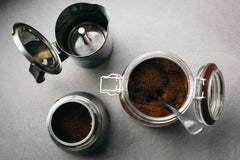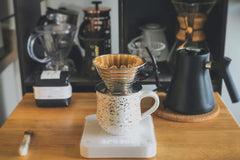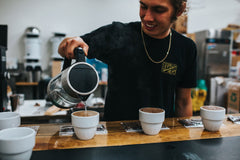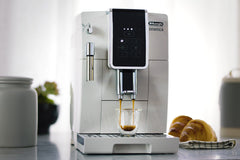Table of Contents
- Coffee Myth #1: Dark Roasts Have More Caffeine Than Light Roasts
- Coffee Myth #2: Espresso Has More Of A Caffeine Jolt Than A Regular Cup Of Joe
- Coffee Myth #3: Espresso Is Only A Type Of Drink
- Coffee Myth #4: Your Coffee Can’t Be Too Hot
- Coffee Myth #6: Freezing Your Coffee Will Maintain Its Freshness Longer
- Coffee Myth #7: Oily Beans Are Fresher Beans
- Coffee Myth #8: The Darker The Roast, The More Flavorful The Coffee
Next to water, coffee is the most consumed beverage in the world.
People from all cultures and all walks of life have been enjoying the brewed beverage for centuries. With its rich history and integral place in our lives, there is a lot to know and learn about coffee.
There is plenty to misunderstand as well.
Over time, certain myths about coffee continue to circulate and live on. We would like to address some of the most common coffee myths and set the record straight.
Coffee Myth #1: Dark Roasts Have More Caffeine Than Light Roasts
Is there a better way to start the day than inhaling the rich aroma of a perfectly roasted coffee?
Everyone has their own opinion about the best roast for an early morning brew, and many people believe that the darker the better. This is in part because of the common misconception that a darker roasted bean contains more caffeine than a lighter roast.
We can see where this seems logical. A dark roast is rich in color, and robust in aroma and flavor. Why wouldn’t it be “richer” in caffeine content too?
The fact is that most coffee beans contain roughly the same amount of caffeine, regardless of the roast.
Notice that we said “roughly.” There are marginal differences among roasts, except it is the lighter roasted beans that are more likely to provide an extra jolt in your cup.
When heat is applied to a green coffee bean, it slowly gets darker, eventually becoming a rich shade of brown. The darker the bean, the longer it has been roasted.
Heat decreases the amount of caffeine in a bean. Lighter roasts have marginally more caffeine because they have been exposed to heat for a shorter period during the roasting process.
Traditional morning or breakfast blend coffees are typically crafted from a blend of lighter to medium roasts for this very reason.
Still prefer a richer, darker roast in the morning?
If so, no need to worry, since the actual difference in caffeine content between type of roast is negligible and won’t make much of a difference in your morning cup.

Coffee Myth #2: Espresso Has More Of A Caffeine Jolt Than A Regular Cup Of Joe
Wander into a coffee house and ask anyone, except maybe the barista, which drink has the highest amount of caffeine, and most of the time the answer will be espresso.
While espresso has the reputation of being the caffeine powerhouse, you might be surprised to know that a standard twelve-ounce cup of coffee has more caffeine than a single shot espresso drink.
This misconception about espresso is centered around the fact that a shot of espresso is more concentrated than a standard brew. Espresso is traditionally served in a small, single shot cup because of its concentration. Espresso is creamy, thick and slightly bitter with a beautiful crema on top. It seems only logical that a coffee this concentrated would be higher in caffeine.
A standard two-ounce shot of espresso contains roughly 80 milligrams of caffeine, while a standard brew, twelve-ounce cup of coffee contains about 120 milligrams of caffeine comparatively.
To be fair, in an ounce per ounce comparison, espresso brewed coffee does have more caffeine than a standard brew. However, few of us are brave enough to fill our coffee mugs to the brim with shots of espresso.
The next time you are looking for a mid-afternoon pick me up, an old-fashioned cup of joe will give you a bit more of an edge than a single shot espresso drink.

Coffee Myth #3: Espresso Is Only A Type Of Drink
In the world of coffee, espresso is often misunderstood.
Espresso is a word that is used to describe a creamy, concentrated coffee that is brewed using a specific technique. However, espresso is so much more than that:
- Espresso is a method of brewing coffee to produce a thick, strong drink with a creamy layer called crema that floats delicately on top. Espresso is also used as a component in coffee drinks such as lattes, cappuccino, and red eyes.
- Espresso is also a word that is used to describe the degree of roast on the coffee bean. When a bean is described as having an espresso roast, it means that it has been roasted until it has an internal temperature of at least 240°F and takes on a dark chocolatey, almost black hue. Other words used to describe a dark roasted coffee include French Roast, Italian Roast and Spanish Roast
- Espresso is not a type of bean. Any origin of bean can be roasted to an espresso color, and any coffee bean can be used to craft a shot of espresso, although dark roasts are generally preferred.
- Espresso is not a type of grind. When crafting a shot of espresso, finely ground coffee is used. You can sometimes find “espresso” ground coffee, however all this means is the bean that was ground to a finer consistency and is suitable for an espresso machine or possibly a Moka Pot.
- Espresso can be a blend of beans; however, it can also be a straight origin. The type of beans and roasts in an espresso blend will vary from one roaster to the next.
Coffee Myth #4: Your Coffee Can’t Be Too Hot
We love a hot, steamy cup of coffee; however, it is possible for your coffee to be too hot.
Have you ever noticed that coffee tastes a certain way when you pour it fresh from the pot, however if you leave it sitting long enough to cool to room temperature it begins to take on new flavor profiles? This is because the subtle notes that you taste in your coffee are dependent upon temperature.
For optimal flavor, it’s suggested that hot coffee be enjoyed in the range of 155°-175°F.
At temperatures greater than 175°F, the rate of oxidation increases, leaving you with a more bitter tasting cup of coffee.
Coffee that is brewed at temperatures greater than 205°F, which is close to boiling, can become burnt, replacing your favorite flavors notes of coffee with bitterness and char.
Save your taste buds from this experience, and from scalding, by brewing your coffee in the optimal heat range.
Coffee Myth #5: The Freshest Beans Always Produce The Best Cup of Coffee
Freshness is one of the most important factors in producing a great cup of coffee.
We tend to think of the peak period for drinking roasted coffee in terms of how long we have before it loses its freshness, rather than how long we should wait before we enjoy it at peak flavor.
The heat involved in the coffee roasting process creates carbon dioxide by breaking down sugars and amino acids in the beans. There is a buildup of carbon dioxide that eventually releases over the next twelve to seventy-two hours.
If you brew your coffee too soon after roasting, the flavor is affected because the beans have not properly “de-gassed,” and the result will be a slightly bitter, sour aftertaste.
Different origins of beans can also taste a little grassy until they have had time to rest after roasting.
Always check the roast date on your coffee, or ask your roaster when your coffee will be at its peak flavor. Most roasts have a peak cycle that starts on day two or three, and then begins to taper off around day ten to fourteen.
Coffee Myth #6: Freezing Your Coffee Will Maintain Its Freshness Longer
There are plenty of people that swear by keeping their coffee beans, ground or whole, in the freezer to preserve freshness.
If they enjoy the way that their coffee tastes using this method, then who are we to argue?
We would like to point out why the freezer, nor the refrigerator, are the best places for your beans.
First, you need to understand that fresh coffee has three natural enemies: air, moisture and heat.
It’s important to keep your coffee in a cool, dark place to maintain freshness, which makes the refrigerator or freezer seem like the perfect spot. The problem is that moisture in these environments will compromise the flavor of your coffee almost immediately.
Coffee beans, whether they are whole or ground, are porous. They absorb the air around them. Cold environments are too damp for coffee, plus your beans can absorb refrigerator odors or become freezer burned.
Instead, keep your coffee stored in an airtight container, away from sources of heat, light and moisture. A dark pantry or kitchen cupboard are perfect options for storing your fresh beans.

Coffee Myth #7: Oily Beans Are Fresher Beans
We love opening a bag of freshly roasted coffee, inhaling the aroma and then letting a few of the slippery toasted beans slip through our fingers. When roasted perfectly, each bean is like a little gem. Like gems, many people think the shinier the better.
A shiny, glossy bean is thought to be a sign of quality and freshness. With coffee, that beautiful oily sheen has nothing to do with freshness, and everything to do with the roast.
Darker coffee varieties, French roast for example, are heated to a higher temperature during the roasting process. The increased temperature of the bean in a darker roast causes the skin on the bean to rupture, pores open and the natural oils escape. This results in that beautiful oily sheen.
Lighter roasts, like a cinnamon roast for example, never reach this point. Lighter roasted coffee will appear dry, sometimes a little dull and “stale.”
The oily appearance on the bean is a sign of the roast and not in any way an indicator of freshness.
You can ensure that you have the freshest possible coffee by purchasing from small batch roasters, only purchasing what you will use within a two-week period, and storing your coffee properly.
Coffee Myth #8: The Darker The Roast, The More Flavorful The Coffee
The individual flavors of coffee are a combination of two components, the bean and the roast. Origin coffees come with their own unique characteristics, which can be enhanced or changed slightly depending on how you roast the bean. Once roasted, grind and brewing method can affect the final flavor as well.
Which combination produces the most flavorful cup of coffee is a common debate, and darker roasted coffees are not a clear winner.
Raw coffee beans start out green, grassy smelling and undrinkable. Through the roasting process, beans lose those raw, grassy characteristics and undergo an incredible transformation.
Each degree of roast, takes the bean further away from those grassy characteristics. By the time a bean has been roasted to the point that it can be considered a dark roast, it barely retains any of the original earthy characteristics and has mellowed considerably.
A lighter roast coffee, because it maintains more complexity and fruit, is considered by some to be the most flavorful of the roasts.
If you are unsure of what flavor components to expect from various roasts, here is a quick description of each.
- Light Roast: Acidic, fruity with a bit of toasted grain
- Medium Roast: Balanced acidity, light fruit, nutty undertones
- Medium Dark Roast: Little acidity, heavier body, spicy undertones
- Dark Roast: Little to no acidity, smooth, mellow, chocolatey or nutty
What is the most flavorful roast for your coffee? The one that YOU like best. You can try a variety of different beans by subscribing to one of our coffee plans.

These eight myths only touch on the many misconceptions surrounding coffee.
Do you have any questions or curiosities about coffee that you would like answered?
If so, please check out some of our other articles or contact us directly with your question at info@nomadcoffeeclub.com.






